Udre Udre

|
Visiting Udre Udre’s
Grave
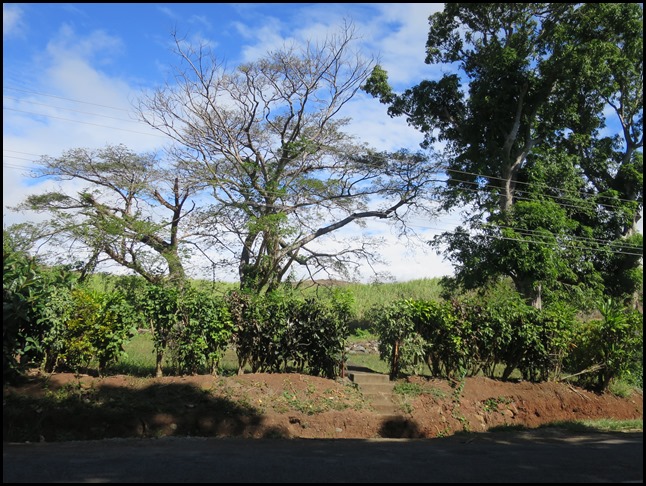 We missed this on
the way past, went on to the town, had some lunch and on the way back
stopped for directions – several times.
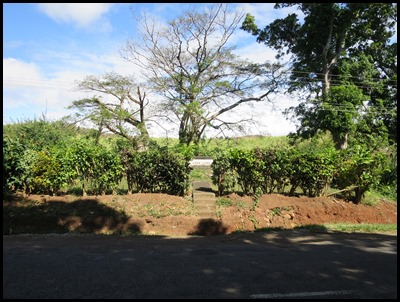 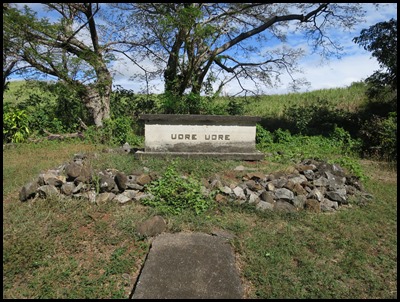 A little
clearer as we crossed the road and finally, through the outer hedge,
there it was, the grave of Udre Udre
Wiki says:
Udre Udre (pronounced [undre 'undre] was a Fijian chief. He holds the Guinness World Record for “most prolific cannibal”. During the 19th century, Udre Udre reportedly ate between 872 and 999 people. He kept a stone for each body he ate; the stones were placed alongside his tomb in Rakiraki, in northern Viti Levu. According to Udre Udre’s son, the chiefs of Rakiraki would go to the battlefield along with Udre Udre and they would each give him every body part of their victims, especially the head, preserving what he couldn’t eat in one sitting for consumption later.
This picture is believed to be that of Udre Udre. In the Fiji Times Online, the following article
written by Avinesh Gopal appeared on Tuesday the 4th of February 2014:
Blood Links to Udre Udre:
No documented evidence has been found yet on how he died, but it has been documented that he had a son named Ravatu. However, there is a possibility that he had other children too. There is also documented evidence that he ate between 872 and 999 people during his reign in the 1800’s. For the past few weeks, much has been revealed by a group of villagers about Fiji's cannibal king. He was Udre Udre and the name itself created fear in people and to some extent it still does now. It wasn't until a few weeks ago that villagers took The Fiji Times and Nai Lalakai team on a tour of where he lived. The cannibal's village was known as Korolevu and the hill where it was located is Dakudaku. It is opposite Vatusekiyasawa Village, which is about five kilometres from Rakiraki Town. Remnants of the cannibal's fort, such as stone walls, lovo pit, water source, house mounds are still visible to this day. The stones on which he kept the "lali", which he beat to show his hunger for humans, are still placed on the hilltop. Vatusekiyasawa villagers have given this newspaper an exclusive history of Udre Udre, including unlimited visits to his abode. The story has been traced from the place he lived in the Nakauvadra mountain range, in a village then known as Draqara. During the tribal war in Rakiraki, which started at a place called "bole" in the mountain range, people from Draqara moved. Udre Udre and his followers moved to the coast of Rakiraki while a group is believed to have gone to Lovoni in Ovalau and others to places in Tailevu. At the coastal area, Udre Udre had a prison in the mangroves called baitiritiri, where he kept his "would-be meals". For some reason, he and his followers moved to Dakudaku and established their village there. The stones used for the walls on three sides of the cannibal's fort are said to have been carried from a river about three kilometres down. And it's said that with their "strange" or "amazing" powers, Udre Udre and his people blocked a place in the river and got water in the hills. With much revealed by Vatusekiyasawa villagers about Udre Udre, the question that lingered in my mind was how they know so many things that are not even documented. The revelations were from the stories passed down by their forefathers and through the visits to the sites during childhood, guided by their elders. On further probing, some villagers have for the first time revealed that they are the descendants of Udre Udre. "Whatever I've told you people so far was from the stories told to me by my forefathers from the time I was small," said a Vatusekiyasawa villager Epeli Bukadogo. "My grandfather told me everything about Udre Udre, who was the cannibal king in the Rakiraki area and Fiji during his time. "No one in the Rakiraki area knows about him because only we have a connection. Vatusekiyasawa Village is the only one so close to Dakudaku. "Vatusekiyasawa Village has been here since the time Udre Udre lived on Dakudaku, thus we have the blood ties. We are the true descendants of Udre Udre. Only my forefathers knew the real life story about Udre Udre and it was passed down to me. But the only thing they didn't tell me was how he died. I believe he was shot dead by the colonial government officials at that time." Mr Bukadogo, however, said what was mysterious was that Udre Udre lived on Dakudaku but his grave is located a few kilometres away. His brother Amani Nailava also said they were the real descendants of Fiji's and the world's "most prolific" cannibal. During some visits to Udre Udre's abode in recent weeks, the group of Vatusekiyasawa villagers had hinted that they had a connection to Udre Udre. They spoke about walking alone in the hills without having any eerie feeling, unlike what some outsiders who went there experienced. Mr Bukadogo said his mataqali was the only one that owned land in Rakiraki from Udre Udre's era until 1917 when the colonial government officials changed things. "Udre Udre was the king in the Rakiraki area and there was only one landowning unit in Rakiraki at that time, which was ours," he claimed. "After the changes in 1917, our mataqali is left with only 330 acres of land now. Our mataqali was there from Udre Udre's time. We have a direct connection to Udre Udre and apart from us, no one knows so many things about him. Everything that I've told you is the truth." Mr Bukadogo said there was no clear evidence on whether the person Ravatu mentioned in one of the books was really Udre Udre's son. The question that also lingers is in what year and exactly how did the cannibal meet his end, whether it was through sickness or "murder". Otto Degner states in his book, Naturalist's South Pacific Expedition in Fiji that one Miss Cumming counted 872 stones, although at least 30 had been removed since Udre Udre's death in about 1840. A research on the internet and the Fiji Museum has also not shown any evidence of when and how the cannibal died. The question "when did Udre Udre die" posed to the website answers.com gives the rather spooky answer "he is still alive". Some people believe that his spirit is still alive where he is last known to have lived on Dakudaku. Thus, the Dakudaku hills are forbidden territory and a place that an outsider should not dare to go alone. We were lucky to have an exclusive tour of what was once Udre Udre's home, thanks to the villagers of Vatusekiyasawa. Mmm. He knew he would get immortality if he ate a thousand but as he fell short of that number, we believe he is safely here and not bimbling about.  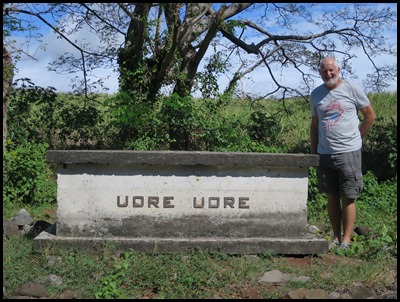 Of course we did the tourist pictures.
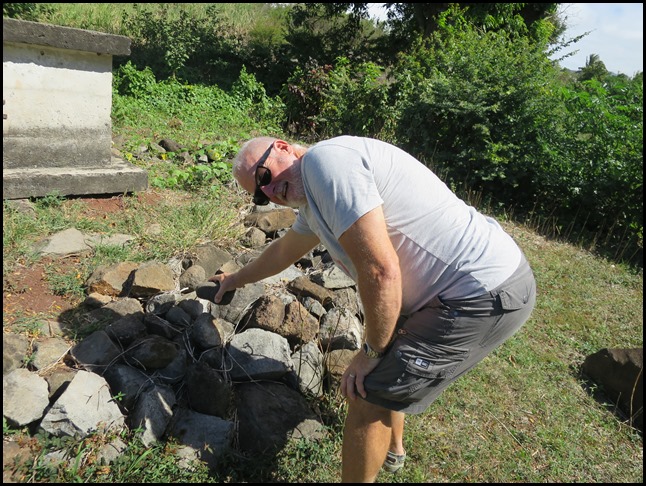 Bear even tidied a
few fallen stones, each one a person
eh.......
According to Deryck
Scarr ("A Short History of Fiji", 1984, page 3), "Ceremonial occasions saw
freshly killed corpses piled up for eating, 'Eat me!' was a proper ritual
greeting from a commoner to a chief." Scarr also reported that the posts that
supported the chief's house or the priest's temple would have sacrificed bodies
buried underneath them, with the rationale that the spirit of the ritually
sacrificed person would invoke the gods to help support the structure, and "men
were sacrificed whenever posts had to be renewed" (Scarr, page 3). Also, when a
new boat, or drua,
was launched, if it was not hauled over men as rollers, crushing them to death,
"it would not be expected to float long" (Scarr, page 19). Fijians today regard
those times as "na gauna ni tevoro" (time of the devil). The ferocity of the
cannibal lifestyle deterred European sailors from going near Fijian waters,
giving Fiji the name Cannibal
Isles; as a result, Fiji
remained unknown to the rest of the
world.
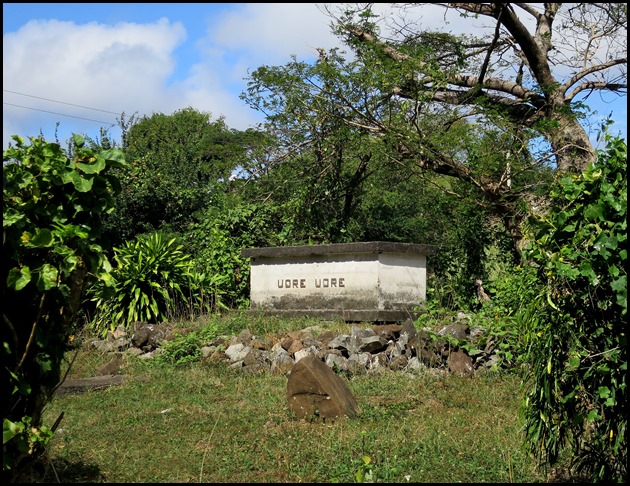 ALL IN ALL WELL, THAT’S A STRANGE
ONE
AN UNUSUAL ACHIEVEMENT, BOTH IN TERMS OF WHAT HE DID AND US VISITING
HIM |
